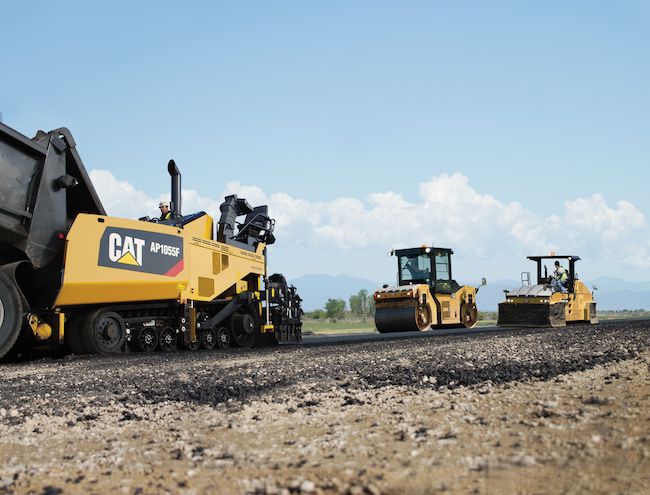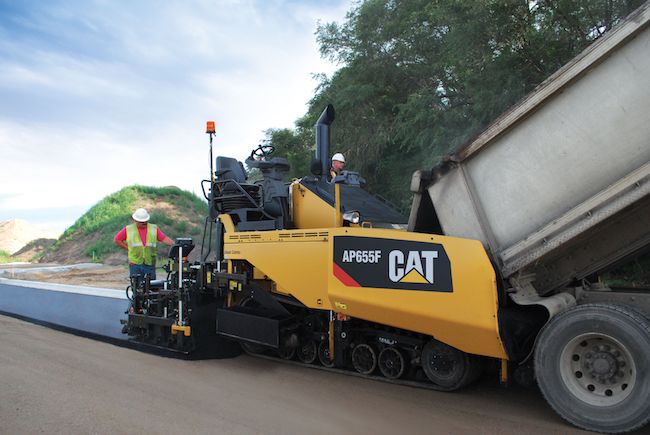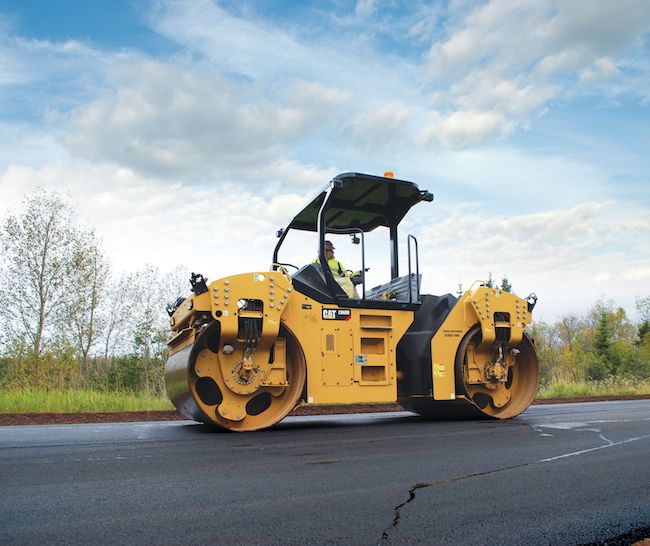
Faster, smarter, safer: The eight key technologies powering paving
By Sheldon Allan
Asphalt Equipment Equipment Technology
In recent years, technology has begun to play an ever-larger role in paving. PHOTO: Finning
Paving operators work in a challenging industry. Not only are they dealing with a perishable product, they need to know how to operate incredibly specialized equipment and deliver precisely under extreme time pressures. Like other industries, 2020 also brought instability, a scarcity of skilled labour and new safety regulations. Combined with increased competition, tighter deadlines and enhanced government regulations and fines – there is more pressure than ever in the industry to deliver projects on time and on, or under, budget.
Technology is slowly starting to shape the industry. Helping to improve productivity and the quality of results; transforming operations, creating greater efficiencies and having a real-time effect on the paving process.
From equipment telematics and software to thermal mapping and process monitoring systems, we are starting to see how technology can contribute to each stage of the paving process. Sheldon Allan, paving and compaction product manager at Finning Canada discusses how paving operations are becoming faster, smarter and safer and shares eight key technologies he feels are making the biggest impact on the industry.
1. Telematics — Key to remote equipment utilization and health
Telematics is driving big change on paving sites and when done correctly can affect every aspect of operations – from the back-office to on-site execution. Data can be tracked from every job site with real-time information to provide a better understanding of the job to schedule equipment and operators.
With telematics you can access data on machine hours and location, plan for equipment repairs with scheduled maintenance, and order parts for just-in-time delivery. Paving material can be delivered exactly when and where it is needed, and you can track the delivery in real-time from the plant to the paver. Telematics can also be linked with a range of apps for site managers to view each cycle time of the truck, from waiting on site, to what route they are taking to know if any delays are expected.
2. Compaction measurement technology — Get it right the first time
Compaction is one of the most important processes in roadway or runway construction and is essential to the durability of the surface. It helps ensure high quality and uniformity of pavement layers to ensure long-lasting performance.
Compaction measurement technology for asphalt is accelerometer-based which means it can measure the stiffness of the different layers (wear/ intermediate/binder) and a portion of the material in the base depending on the stage and thickness being compacted. The stiffness is represented as a composite value and when used in conjunction with a nuclear density gauge, it can aid in pass optimization and help identify whether you are over or under compacting. It measures up to two feet deep on all layers to determine the overall stiffness of the surface and allows you to see data in real-time to make adjustments as needed. By controlling consistency and process improvements you gain greater quality and accuracy, leading to less re-work and lower costs.
3. Increased use of onboard temperature sensors
All asphalt mixes have a certain temperature zone for optimal compaction. Compacting when the mix is too hot causes the mix to move in front of the drum rather than under the drum. When the mix is too cold, the binder becomes stiff, making aggregate movement very difficult, or impossible. Incorrect asphalt temperatures can lead to poor density, low pavement quality and in some cases, costly re-work. This can be avoided with the use of onboard real time infrared temperature sensors. Asphalt temperature is taken from the front sensor if the machine is going forward and from the rear sensor if it is reversing, ensuring the temperature remains consistent. More sophisticated systems have an onboard air compressor to assist with keeping the temperature sensor lens clean, removing the need for hand-held devices.

Onboard temperature sensors to ensure optimal compaction are finding increased usage throughout the industry. PHOTO: Finning
4. Thermal regulation – moving to an industry standard
Understanding that asphalt mixes have optimum compaction temperature zones is very important to laying the asphalt at as consistent a temperature as possible behind the paver. Asphalts that do not have a consistent temperature across the mat are said to be thermally segregated. Compacting thermally segregated asphalt creates different densities across the surface of the road. Thermally segregated pavement doesn’t just lead to bad results, it can also impact safety and surface durability. Thermal regulation technology is continuing to improve, building more durable, longer lasting surfaces that can handle heavy loads and high traffic volumes.
One of the biggest challenges is understanding temperature variation and specifications for smoothness. Thermal mapping monitors the surface temperature of the asphalt mat using an infrared sensor and/or camera along with a global navigation satellite system mounted directly on the machine for positioning. By viewing temperatures in real-time, contractors can manage every stage of the paving process, identifying any variations and taking action immediately to fine-tune the work as they go and ensure more uniform lay-down temperatures.
Sharing the mapping data from a remote location in real-time can help with better documentation and prove due diligence. It can also be analyzed to create efficiencies in the process and for gaining insights for bidding on future jobs.
5. Machine-to-machine communication
Sharing information between machines helps ensure rolling patterns are coordinated. By sharing coverage and pass-count maps via the operating displays on multiple machines, operators can stay properly informed during a project.
Nighttime can make it difficult to see where a compactor has been, and operators might question the stopping point on a previous pass or whether the mat temperature was in the proper range. Machine-to-machine communication can help operators feel confident that they have completed all their passes, corrected any areas of missed coverage and made the necessary adjustments to ensure they are in the correct temperature zone for compacting.
6. New software tools creating greater efficiencies
Technology has changed the paving industry and has revolutionized the way we communicate on job sites. We now have the tools to help us make better decisions — this includes access to a range of applications and software programs to support telematics and allow for greater connectivity. In the past, software updates would be done by a dealer or technician at the machine’s physical location. Now, much like software on your phone, this can be done remotely to ensure you always have access to the latest and greatest software.
The use of software tools is saving time and reducing paperwork. Invoices can be validated and double checked online. Equipment hours and utilization data from the job site can be sent directly to payroll and any safety related issues or concerns can be saved in one central location.
Apps can also help with training opportunities and planning for future work by calculating the number of trucks required and the estimated duration of any paving job, including cool-weather paving. This helps reduce costs and improve productivity.

In the not-too-distant future, operators will likely be able to hand control to automated systems that can carry out the paving process accurately and efficiently. PHOTO: Finning
7. Process Monitoring Solutions — it’s all about consistency and timing
One of the first steps to any paving job is moving material from the asphalt plant to the job site. The production of the paver is directly tied to the availability of material, and it is key to keeping jobs on track. Previous methods would have involved using a manual ticket system with little communication between dispatchers and drivers. As a result, vehicle location and estimated delivery time were a guessing game.
Process monitoring solutions allow operators to deliver material exactly when and where it is needed. Deliveries from the plant to the paver can also be tracked in real-time and the system can be linked with an app. This lets site managers see each cycle time of the truck, from wait time, to the route travelled, and identify if any delays are expected so they can make adjustments as needed.
8. Emerging Automation
We are also starting to see more widespread adoption of semi-autonomous technologies. In the not-too-distant future, operators with little to no experience will be able to program the parameters of the job site into the machine, including speed and number of passes and it will control every aspect of the paving process, allowing for complete accuracy and efficiency. Combined with advancements in safety technology, this will also help to attract the skilled labour needed to address the shortage in the industry and pave the way for the next generation of workers.
Further advancements in technology will result in even greater connectivity and increased safety in the paving industry. With so many factors to consider, technology is an obvious solution – it can help create greater efficiencies, streamline operations and keep workers safe.

Sheldon Allan is the Paving product manager at Finning Canada. He has over 15 years experience in the paving sector, starting as a field technician on paving equipment. His expertise includes the operation, maintenance and training on Caterpillar and Weiler products. As the Paving product manager, he leads the team that provides equipment, compaction and new technology support to customers in the paving industry across Western Canada.




